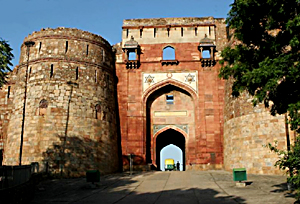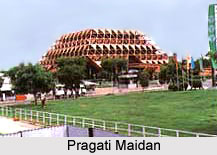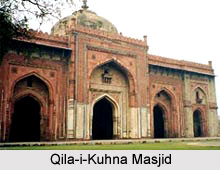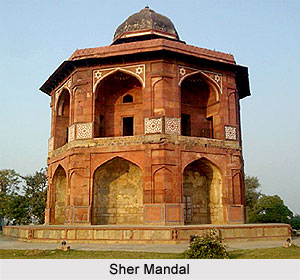Purana Quila in Delhi has been built on a small hill standing on the banks of river Yamuna with its massive rubble wall and imposing gateway houses. The structure houses a mosque, which has a double storied octagonal tower. According to Hindu literature the fort marks the site of Indraprastha, the magnificent capital of the Pandavas, though an Afghan ruler Sher Shah Suri carried out the construction between 1538 to 1545 in the 3rd century who wrested the throne of Delhi from the Mughal emperor Humayun. It is said that the Mughal king Humayun fell from tower accidentally and died.
History
When the second Mughal emperor Humayun decided to make a city of his own he decided on the site of the ancient city of Indraprastha. Humayun was quite a scholar with a fine grasp on such matters and so it is certain that the site was chosen deliberately. When Sher Shah Suri overthrew him, he destroyed most of Dinpanah (refuge of the faithful) as the city of Humayun was called to make way for his own Dilli Sher Shahi or Shergarh. Incidentally, Humayun was probably the only emperor in history who built a city in Delhi and did not give it his own name this was typical of Humayun`s rather sophisticated and dreamy character.
 Some Mughal historical documents indicate that Humayun died as a result of the injuries he suffered after falling down from the steps of the Sher Mandal. Rumours exist that after the death of the Humayun, the Mughals, considering the fort to be cursed, vacated the structure. As a consequence, the Mughals had to construct a new fort, known as Lal Quila (Red Fort), to defend Delhi from foreign invasions.
Some Mughal historical documents indicate that Humayun died as a result of the injuries he suffered after falling down from the steps of the Sher Mandal. Rumours exist that after the death of the Humayun, the Mughals, considering the fort to be cursed, vacated the structure. As a consequence, the Mughals had to construct a new fort, known as Lal Quila (Red Fort), to defend Delhi from foreign invasions.
The discoveries made in the Purana Qila excavations tell us about the lives of people who lived here hundreds of years ago. The earliest houses belonged to about the forth century B.C. They were made of sun-dried bricks as well as bricks baked in kilns. Houses had drains, which carried wastewater into soak pits dug into the ground. Many terracotta figurines of humans and animals were found. So was a special kind of shiny pottery that archaeologists call Northern Black Polished Ware (NBP for short). People had started using copper coins for buying and selling things. Traders used seals to mark their bales of merchandise.
Site & Architecture
 In plan the Old fort, now simply called Purana Qila by Delhites, is irregularly orbital. The walls of the immense Qila tower down on the road that takes one to Pragati Maidan from the height of 18m, and run on for about 2km. It has three main gates - the Humayun darwaza, Talaqi darwaza and Bara darwaza (which one uses to enter the fort today). The double-storeyed gates are quite huge and are built with red sandstone. Of all the gates entry was forbidden from Talaqi (forbidden) darwaza, the northern gate. The architect of Purana Quila has shown skill by enriching each part with molding, bracketed openings, marble inlay, carving and other establishments. A variety of materials have also been used to construct the small mosque. The entrance arch is of marble, the spandrels of red sandstone studded with marble bossed, the columns and pilasters of black and white marble.
In plan the Old fort, now simply called Purana Qila by Delhites, is irregularly orbital. The walls of the immense Qila tower down on the road that takes one to Pragati Maidan from the height of 18m, and run on for about 2km. It has three main gates - the Humayun darwaza, Talaqi darwaza and Bara darwaza (which one uses to enter the fort today). The double-storeyed gates are quite huge and are built with red sandstone. Of all the gates entry was forbidden from Talaqi (forbidden) darwaza, the northern gate. The architect of Purana Quila has shown skill by enriching each part with molding, bracketed openings, marble inlay, carving and other establishments. A variety of materials have also been used to construct the small mosque. The entrance arch is of marble, the spandrels of red sandstone studded with marble bossed, the columns and pilasters of black and white marble.
Sher Shah Suri and his successor could not complete the city, and when Humayun defeated Sher Shah`s son to take back his city, he did not deal with Dilli Sher shahi as the latter had done with Dinpanah. In fact the Mughal emperor very handsomely completed the city and even used several of the buildings like the Sher Mandal, a rather pretty two-storeyed octagonal building. Humayun used this as his library and, then tripped to his death from its steps. One of the most fascinating buildings, and also one of the few that still survive, in the Purana Qila is the Qila-i-kuhna masjid. Sher Shah Suri built it in 1541 and he was obviously out to make a definite style statement. The mosque is quite a place; its prayer hall measures 51.20m by 14.90m and has five doorways with the `true` horseshoe-shaped arches.
 Apparently the idea was the build the whole mosque in marble, but the supply ran out and red sandstone had to be used instead. But the builder used the material at hand very skillfully and the result is quite spectacular the red sandstone and the marble contrast beautifully with each other to give the mosque a very distinctive air. The mihrabs (prayer place) inside the mosque are richly decorated with concentric arches. From the prayer hall, staircases lead you to the second storey where a narrow passage runs along the rectangular hall. A beautifully worked dome tops the central alcove. In the courtyard at one time there was a shallow tank, which had a fountain. The mosque has an inscription which says `As long as there are people on this earth, may this edifice be frequented, and people be happy in it.` The mosque, built around 1541-42, is a landmark in Indo Islamic architecture.
Apparently the idea was the build the whole mosque in marble, but the supply ran out and red sandstone had to be used instead. But the builder used the material at hand very skillfully and the result is quite spectacular the red sandstone and the marble contrast beautifully with each other to give the mosque a very distinctive air. The mihrabs (prayer place) inside the mosque are richly decorated with concentric arches. From the prayer hall, staircases lead you to the second storey where a narrow passage runs along the rectangular hall. A beautifully worked dome tops the central alcove. In the courtyard at one time there was a shallow tank, which had a fountain. The mosque has an inscription which says `As long as there are people on this earth, may this edifice be frequented, and people be happy in it.` The mosque, built around 1541-42, is a landmark in Indo Islamic architecture.
Several excavations have taken place in the Purana Qila in an attempt to prove, or disprove as the case may be, whether it is indeed the site of Indraprastha or not. Diggings have yielded Painted Grey Ware pottery, which has been dated to 1000BC. Similar stuff has been noticed in other sites associated with the epic Mahabharata as well, which seem to conclusively prove that this indeed was the place where Indraprastha once flourished. These excavations have also thrown up material, like coins, associated with the Gupta about 4-5th century AD and post-Gupta ages 700-800AD of Indian history as well.
 Another building of interest inside the fort is the Sher Mandal an octagonal building made up of red sandstone. The two-storied pavilion has steep steps leading up to the roof. After Humayun recaptured Delhi in 1555, he refurbished the Sher Mandal into his library. It was here that Humayun fell to his death a year later. The Old Fort was the citadel of the city of Dinapanah (Refuge of the Faithful), which Humayun started building in 1533 and completed five years later. When Sher Shah Suri the Afghan King defeated Humayun, he renamed the fort as Shergarh and added some more buildings within the complex. Out of the three entrances that Purana Qila had, only one remains open till date the Bara Darwaza. Today, the Purana Quila (Old Fort) houses the Delhi Zoo, Delhi`s largest zoological park, and a boat club. The historic structure of the Purana Qila has stood witness to the restoration of the city of Delhi, the periods of anarchy, and the rise and fall of empires.
Another building of interest inside the fort is the Sher Mandal an octagonal building made up of red sandstone. The two-storied pavilion has steep steps leading up to the roof. After Humayun recaptured Delhi in 1555, he refurbished the Sher Mandal into his library. It was here that Humayun fell to his death a year later. The Old Fort was the citadel of the city of Dinapanah (Refuge of the Faithful), which Humayun started building in 1533 and completed five years later. When Sher Shah Suri the Afghan King defeated Humayun, he renamed the fort as Shergarh and added some more buildings within the complex. Out of the three entrances that Purana Qila had, only one remains open till date the Bara Darwaza. Today, the Purana Quila (Old Fort) houses the Delhi Zoo, Delhi`s largest zoological park, and a boat club. The historic structure of the Purana Qila has stood witness to the restoration of the city of Delhi, the periods of anarchy, and the rise and fall of empires.



















